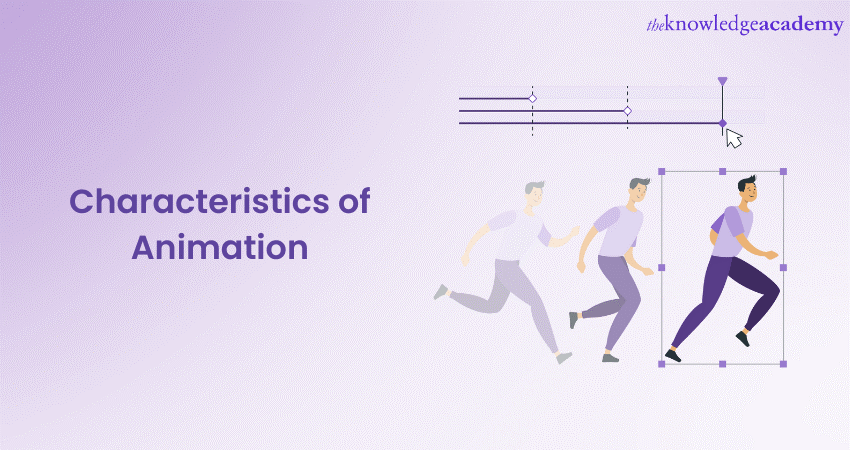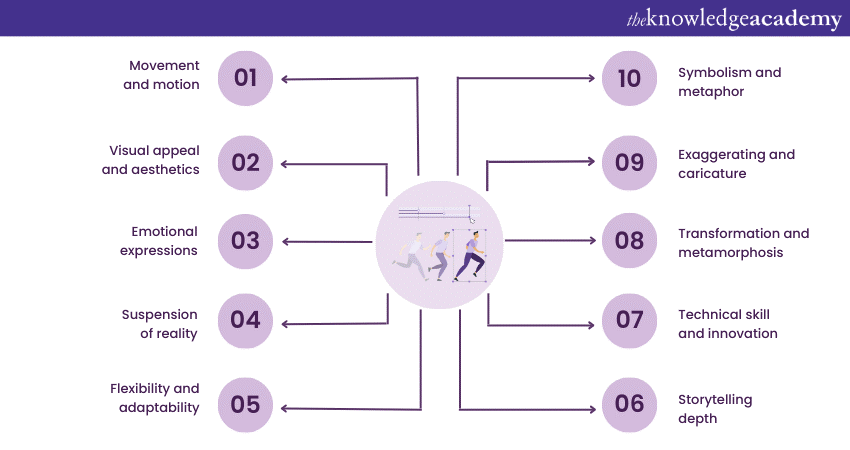We may not have the course you’re looking for. If you enquire or give us a call on +357 26030221 and speak to our training experts, we may still be able to help with your training requirements.
Training Outcomes Within Your Budget!
We ensure quality, budget-alignment, and timely delivery by our expert instructors.

Animation is a captivating form of visual communication that has captured the imagination of people for decades. From classic cartoons to modern CGI masterpieces, 3D Animation has evolved into an intricate art form with its own set of unique characteristics. In the digital age, the Characteristics of Animation have evolved beyond storytelling, becoming a versatile tool for conveying information and structure. Let's explore the fascinating world of Animation and uncover the details that set it apart.
Table of Contents
1) Definition of Animation
2) Characteristics of Animation
a) Movement and motion
b) Visual appeal and aesthetics
c) Emotional expressions
d) Suspension of reality
e) Flexibility and adaptability
3) Conclusion
Definition of Animation
The term Animation finds its origins in the Latin word "anima," which means "soul" or "spirit." Animation breathes life into static images, infusing them with vitality and personality. It's the art of making characters leap off the page, dance across the screen, or come to life in any chosen medium.
On the other hand, technological Animation involves the manipulation of digital elements, often within a computer-generated environment, to simulate motion. This is achieved by breaking down the movement into a sequence of frames, similar to traditional Animation techniques, and then displaying these frames in rapid succession. This rapid display creates the perception of fluid motion, allowing users to interact with and experience dynamic visuals that respond to their input.
Learn more about animation and its characteristics by registering for our Animation and Design Training today and kickstart your career!
Characteristics of Animation
Animation, as a vibrant and versatile medium, possesses distinct characteristics that contribute to its widespread appeal and creative potential. These characteristics are what make it a captivating form of visual communication, capable of transcending cultural boundaries and evoking profound emotions. Let's get into these characteristics, accompanied by illustrative examples from iconic Animations:

Movement and motion
The essence of Animation lies in its ability to bring static images to life through movement and motion. Animators achieve this by creating a series of frames, each slightly different from the previous one. When these frames are placed in rapid succession, they create the illusion of movement. This meticulous manipulation of frames is what gives life to characters, objects, and scenes.
A classic example is the iconic Disney character Mickey Mouse. In his various adventures, Mickey's fluid and dynamic movements transform a simple image into a lively and relatable personality.
Visual appeal and aesthetics
One of the key Characteristics of Animation is its visual appeal. Animators use a wide range of artistic styles, colour palettes, and visual techniques to create stunning visuals that capture the viewer's attention. From the vibrant hues of a children's cartoon to the sophisticated realism of a CGI film, 3D Animation allows for limitless creativity in crafting unique visual worlds.
Animation encompasses a myriad of artistic styles, ranging from highly stylised to hyper-realistic. Each style contributes to the uniqueness of a production. For instance, the hand-drawn charm of Studio Ghibli films, such as "My Neighbor Totoro," evokes a sense of nostalgia and warmth.
Emotional expressions
Animation has the remarkable ability to convey complex emotions through characters and their actions. The exaggerated expressions and gestures of animated characters enable them to communicate emotions in a way that resonates with audiences of all ages. While showcasing a joyful dance, a tearful farewell, or a comical mishap, Animation amplifies emotions and creates a strong connection between viewers and characters.
For example, 3D Animation characters have a unique ability to convey emotions through exaggerated expressions. Movies like Pixar's "Up" demonstrate this characteristic perfectly. The opening sequence, without a single word, masterfully evokes feelings of love, loss, and adventure through the expressions of its characters.
Suspension of reality
One of the charms of Animation is its ability to suspend reality and venture into a fantastical kingdom. It transcends the limitations of the physical world, allowing for the portrayal of impossible scenarios, magical creatures, and extraordinary feats. This characteristic lets storytellers explore imaginative concepts that might be challenging to depict in live-action formats.
For example, Animation offers the freedom to explore fantasy beyond the constraints of reality. "Avatar" showcases this by introducing a world where characters can manipulate elements like fire and water, pushing the boundaries of what's possible.
Flexibility and adaptability
Animation is a dynamic medium that can cater to various genres and audiences. It can be light-hearted and comedic, dark and mysterious, or deeply emotional. This adaptability enables Animators to address various themes and narratives, making Animation suitable for all age groups and cultural backgrounds.
Animation adapts to various genres and audiences, from children's cartoons to adult-oriented content. A prime example is "The Simpsons." Its satirical humour appeals to both young and mature audiences, demonstrating Animation's adaptability.
Unlock Creativity with our Animation Masterclass – Register Today and Bring Your Imagination to Life!
Storytelling depth
Behind every captivating Animation is a well-crafted story. Animation allows storytellers to delve into intricate narratives, layering plots and themes that captivate audiences on multiple levels. The ability to weave together compelling stories with the visual allure of Animation is what distinguishes it as an influential storytelling tool.
Animation is not just for light-hearted tales; it delves into intricate narratives. "WALL-E" tells a compelling story of environmentalism, consumerism, and love through the journey of a lovable robot, showcasing Animation's capacity for profound storytelling.
Technical skill and innovation
Animating even the simplest of scenes requires a high level of technical skill and innovation. From hand-drawn Animations to cutting-edge computer-generated imagery, Animators continually push the boundaries of technology to create increasingly sophisticated visuals. This characteristic ensures that Animation remains at the forefront of artistic and technological advancement.
Advancements in technology continually elevate Animation's complexity and realism. The film "Frozen" showcases cutting-edge CGI and intricate character design, highlighting the technical prowess required to create a visually stunning Animation.
Transformation and metamorphosis
Transformation and metamorphosis are powerful storytelling tools in Animation that allow characters to undergo profound changes, both physically and emotionally. These narrative devices enable Animators to convey growth, inner struggles, and themes of self-discovery. Through the process of transformation, characters evolve, often reflecting the universal journey of personal development. Here are some examples that highlight the significance of transformation in Animation:
a) The Little Mermaid: Ariel's transformation from a mermaid into a human symbolises her desire for a new life and the sacrifices she's willing to make for love. This metamorphosis underscores themes of identity and the pursuit of one's dreams.
b) Princess Mononoke: The transformation of the cursed prince, Ashitaka, into a forest spirit embodies the film's environmental themes. As he evolves, he becomes a bridge between humanity and nature, illustrating the interconnectedness of all living things.
c) Shrek: The titular character Shrek, undergoes a transformation from a solitary ogre to someone who embraces companionship and love. This evolution reflects the film's message about acceptance and the transformative power of relationships.
Unlock your creativity with our comprehensive 2D Animation Training. Join Today!
Exaggerating and caricature
Exaggeration and caricature are essential elements of Animation that allow artists to amplify traits, emotions, and expressions to create distinctive and memorable characters. This technique adds depth to characterisation and enhances comedic or dramatic effects. Here are examples that showcase the impact of exaggeration and caricature in Animation:
a) The Incredibles: Edna Mode's exaggerated personality and flamboyant design make her a memorable character. Her diminutive stature and larger-than-life attitude add a humorous touch to the film's superhero world.
b) Tom and Jerry: The rivalry between Tom the cat and Jerry the mouse is defined by exaggerated physical comedy. Their over-the-top reactions and antics contribute to the cartoon's slapstick humour.
c) Madagascar: The character King Julien stands out due to his flamboyant personality and exaggerated movements. His comic relief stems from his larger-than-life ego and eccentric behaviour.
Symbolism and metaphor
Animation excels at conveying complex ideas through symbolism and metaphor, allowing creators to explore profound themes in visually captivating ways. By using imagery to represent deeper concepts, Animation engages audiences on intellectual and emotional levels. Here are examples that illustrate the use of symbolism and metaphor in Animation:
a) Finding Nemo: The journey of Marlin and Dory to find Nemo parallels the parental instinct to protect and guide one's child. The vast ocean they traverse becomes a metaphor for life's challenges and uncertainties.
b) The Lion King: The circle of life symbolises the interconnectedness of all living things. The rising sun during Simba's presentation mirrors his birth and eventual return to his rightful place as king.
c) Ratatouille: The dish ratatouille represents the blend of cultures, experiences, and talents that make individuals unique. The meal's preparation serves as a metaphor for the protagonist, Remy's pursuit of his culinary dreams.
Conclusion
Animation is a multifaceted medium that enchants and entertains audiences while pushing the boundaries of creativity and technology. The distinct Characteristics of Animation, including movement, visual appeal, emotional expression and suspension of reality, contribute to its enduring popularity. As Animation continues to evolve, its influence on the world of entertainment and art remains profound, fascinating generations and leaving an inerasable mark on the creative outlook.
Unlock Your Creativity with our Motion Graphics Masterclass – Register Now and Bring Your Designs to Life!
Frequently Asked Questions
Upcoming Office Applications Resources Batches & Dates
Date
 Animation Course
Animation Course
Tue 17th Dec 2024
Fri 3rd Jan 2025
Fri 7th Mar 2025
Fri 2nd May 2025
Fri 4th Jul 2025
Fri 5th Sep 2025
Fri 7th Nov 2025







 Top Rated Course
Top Rated Course



 If you wish to make any changes to your course, please
If you wish to make any changes to your course, please


